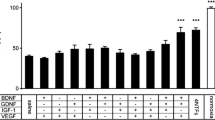Summary
The consequence of neuronal regeneration on the affected cell body has not been well documented previously. The long-term effects of either successful peripheral nerve (sciatic) regeneration or exogenously administered nerve growth factor (NGF) on dorsal root ganglion (DRG) neurons were determined. The degree of neuronal death and changes in neuronal size were measured after various injuries and treatments. The regenerative influence of the transected, distal sciatic-nerve segment on the neuronal cell body was examined under various standardized conditions (e.g. crush, transection followed by immediate epineurial anastomosis or transection with capping of the proximal nerve stump). Neuronal death was greatest in smaller neurons with diameters between 16 and 28 μm. The data showed no difference in the degree of neuronal death between the crush injury and the anastomosis (both able to regenerate). However, the capped, proximal nerve (regeneration prevented) had a significantly higher incidence of neuronal death and less complete recovery from the early neuronal atrophy, which was initially observed in all three groups. The long-term effect on neuronal survival of transient NGF administration (three weeks) at the site of injury demonstrated partial protection by a decrease (55%) in the neuronal loss nine weeks after injury compared to controls. Either the distal nerve segment during regeneration or exogenously applied NGF is capable of mitigating the long-term effects of axotomy in the DRG neuronal cell body.
Similar content being viewed by others
References
Aldskogius, H. &Risling, M. (1981) Effects of sciatic neurectomy on neuronal number and size distribution in L7ganglion of kittens.Experimental Neurology 74, 597–604.
Arvidsson, J., Ygge, J. &Grant, G. (1986) Cell loss in lumbar dorsal root ganglia and transganglionic degeneration after sciatic nerve resection in the rat.Brain Research 373, 15–21.
Bocchini, V. &Angeletti, P. U. (1969) The nerve growth factor: purification as a 30,000 molecular weight protein.Proceedings of the National Academy of Science 64, 787–94.
Cajal, S. Ramon Y. (1928) Experiments dealing with the transplantation of nerves or their products, designed to prove especially an attractive or neurotrophic action on nerve sprouts. InDegeneration and Regeneration of the Nervous System (edited and translated byMay, R.), pp. 329–61. New York: Hafner Press.
Cavanaugh, M. W. (1951) Quantitative effects of the peripheral innervation area on nerves and spinal ganglion cells.Journal of Comparative Neurology 94, 181–219.
Grafstein, B. &McQuarrie, I. (1978) Role of the nerve cell body in axonal regeneration. InNeuronal Plasticity (edited byCotman, C. W.), pp. 155–94. New York: Raven Press.
Heumann, R., Korsching, S., Bandlow, C. &Thoenen, H. (1987a) Changes in nerve growth factor synthesis in non-neural cells in response to sciatic nerve transection.Journal of Cell Biology 104, 1623–31.
Heumann, R., Lindholm, D., Bandlow, C., Meyer, M., Radekey, M. J., Misko, T. P., Shooter, E. &Thoenen, H. (1987b) Differential regulation of mRNA encoding nerve growth factor and its receptor in rat sciatic nerves during development, degeneration, and regeneration.Proceedings of the National Academy of Science, USA 84, 8735–9.
Konigsmark, B. E. (1970) Methods for the counting of neurons. InContemporary Research Methods in Neuroanatomy (edited byNauta, W. J. &Ebbesson, S. O. E.), pp. 315–40, New York: Springer-Verlag.
Lieberman, A. R. (1968) An investigation by light electron microscopy of chromatolytic and other phenomena induced in mammalian nerve cells by experimental lesions. PhD Thesis, University of London.
Lieberman, A. R. (1971) The axon reaction. A review of the principal features of perikaryal responses to axon injury.International Review of Neurobiology 14, 49–124.
Lieberman, A. R. (1974) Some factors affecting retrograde neuronal responses to axonal lesions. InEssays on the Nervous System (edited byBellairs, R. &Gray, E. G.), pp. 71–105. Oxford: Clarendon Press.
Liu, H. M., Balkovic, E. S., Sheff, M. F. &Zacks, S. I. (1979) Productionin vitro of a neurotrophic substance from proliferative neurolemma-like cells.Experimental Neurology 64, 271–83.
Lundborg, G., Longo, F. M. &Varon, S. (1982) Nerve regeneration model and trophic factorsin vivo.Brain Research 232, 157–61.
Otto, D., Unsicker, K. &Grothe, C. (1987) Pharmacological effects of nerve growth factor and fibroblast growth factor applied to the transectioned sciatic nerve on neuron death in adult rat dorsal root ganglia.Neuroscience Letters 83, 156–60.
Politis, M. J., Ederle, K. &Spencer, P. S. (1982) Tropism in nerve regenerationin vivo. Attraction of regenerating axons by diffusible factors derived from cells in distal nerve stumps of transected peripheral nerves.Brain Research 253, 1–12.
Ranson, S. W. (1906) Retrograde degeneration in the spinal nerves.Journal of Comparative Neurology 14, 265–93.
Rich, K. M., Luszczynski, J. R., Osborne, P. A. &Johnson, E. M., Jr (1987) Nerve growth factor protects adult sensory neurons from cell death and atrophy caused by nerve injury.Journal of Neurocytology 16, 261–8.
Richardson, P. M. &Ebendal, T. (1982) Nerve growth activities in rat peripheral nerve.Brain Research 246, 57–64.
Riopelle, R. J., Boegman, R. J. &Cameron, D. A. (1981) Peripheral nerve contains heterogeneous growth factors that support sensory neuronsin vitro.Neuroscience Letters 25, 311–16.
Risling, M., Aldskogius, H. &Hildebrand, C. (1983) Effects of sciatic nerve crush on the L7 spinal roots and dorsal root ganglia in kittens.Experimental Neurology 79, 176–87.
Taniuchi, M., Clark, H. B. &Johnson, E. M., Jr (1986) Induction of nerve growth factor receptor in Schwann cells after axotomy.Proceedings of the National Academy of Science, USA 83, 4094–8.
Taniuchi, M., Clark, H. B., Schweitzer, J. B. &Johnson, E. M., Jr (1988) Expression of nerve growth factor receptors by Schwann cells of axotomized peripheral nerves: Ultrastructural location, suppression by axon contact, and binding properties.Journal of Neuroscience 8, 664–81.
Watson, W. E. (1968) Observation on the nucleolar and total cell body nucleic acid of injured nerve cells.Journal of Physiology, London 196, 655–76.
Weiss, P. &Taylor, A. C. (1944) Further evidence against ‘neurotropism’ in nerve regeneration.Journal of Experimental Zoology 95, 233–57.
Author information
Authors and Affiliations
Rights and permissions
About this article
Cite this article
Rich, K.M., Disch, S.P. & Eichler, M.E. The influence of regeneration and nerve growth factor on the neuronal cell body reaction to injury. J Neurocytol 18, 569–576 (1989). https://doi.org/10.1007/BF01187077
Received:
Revised:
Accepted:
Issue Date:
DOI: https://doi.org/10.1007/BF01187077




